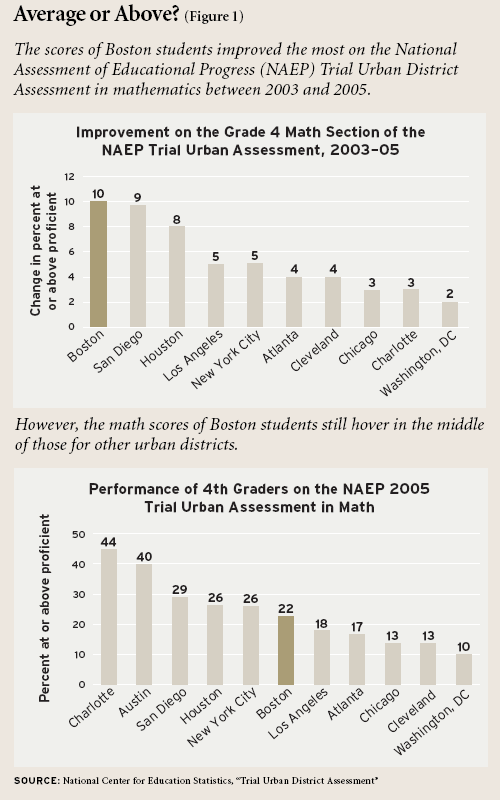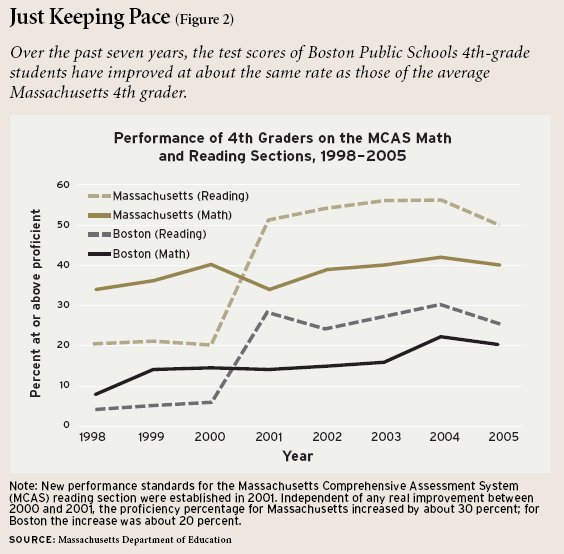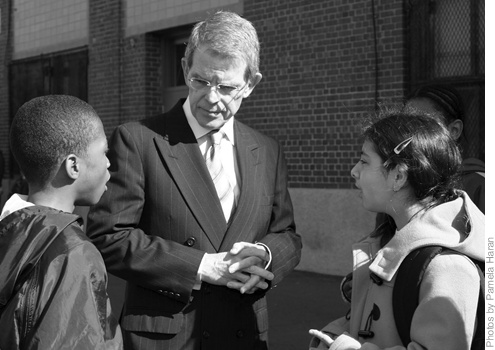In a national landscape dotted with dysfunctional urban school systems and short-lived superintendencies, the Boston Public School district (BPS) and its superintendent, Tom Payzant, both stand out. With over a decade at the helm, Payzant is arguably the best big-city school leader in the nation and Boston the most improved urban district. This June he retires.
The success side of the Payzant story is known to many. Academic progress in Boston increased steadily under his leadership, with Boston’s 4th and 8th graders handing the 65-year-old Boston native a nice farewell gift by coming out on top in math improvement on the National Assessment of Educational Progress (NAEP) 2005 assessments among ten participating urban districts (see Figure 1). Boston public school students are also among the top (along with San Diego and New York) in making the most overall progress over the past two years, outperforming students in Atlanta, Cleveland, and Chicago. Boston has a smaller gap than most other urban districts in achievement between white students and black and Hispanic students. On state tests, Boston’s scores have almost kept pace with the state average since the tests were first given in 1998. The district has been a finalist for the Broad Foundation award for urban school districts for each of the past four years.

Payzant himself has won numerous awards, including state and national superintendent of the year. He was recently named one of Governing magazine’s public officials of the year—the only school official to be so recognized. He has been praised for his intelligence and his doggedness, traits that many believe are key to understanding his success over almost 40 years as an educator.
He reads voraciously and responds to an enormous amount of e-mail. His stamina has abandoned him only once, five years ago, when he fell ill with viral meningitis and had to take a few weeks off to recuperate. A grandfather of five, Payzant is still working long days, nearly every day of the week, right up to retirement.
For his hard work and depth of knowledge, Payzant is admired almost universally in mainstream education circles. “Everybody likes Tom a lot and really respects him,” says Harvard Graduate School of Education professor Susan Moore Johnson. “I don’t think there’s any doubt that the district is better off for having him here.”
But even in the praise there is a hint of what it is about this Harvard-educated superintendent that frustrates people. “Many people would like the pace to quicken here,” says Moore Johnson, who calls herself a Payzant supporter. “I think people would like to see more improvement on test scores, stronger schools, and more autonomy given to those schools that are performing well.”
Indeed, the most common criticism of Boston’s improvement—and Payzant’s leadership style—is that there isn’t more of it; the changes have been “incremental,” suggesting that he could have made more substantial, dramatic, or even radical changes, but instead made only small moves that produced marginal achievements (see Figure 2).

And so a question lingers: Could Tom Payzant have done more? Other, more flamboyant and hard-charging district leaders, like former San Diego superintendent Alan Bersin and former Chicago superintendent Paul Vallas, have come and gone (some of them, like Vallas, popping up again in new locations), while Payzant remained. And yet, the appeal of the hard-charging noneducator (think Roy Romer in Los Angeles) remains powerful.
As it turns out, the questions often have as much to do with expectations thrust on him, and the differing ideologies surrounding school reform, as with Tom Payzant himself or the results that he did and did not achieve.
These questions certainly aren’t parochial or relevant to Boston alone. Many other major school districts are currently trying to decide whether to find someone who can emulate Payzant’s focused strategy or someone who is going to break down doors and take few prisoners.

A Life in Education
Born Thomas William Payzant on November 29, 1940, in Boston, a third-generation French-American (via Nova Scotia), the future educator moved to nearby Quincy in his early years. He attended public school there until his mother packed him off to the private Mount Hermon School for Boys, founded by famed Protestant evangelist Dwight Moody (in 1881). Payzant says he considers it a great sacrifice on his mother’s part to send him to Mount Hermon, in part because it meant she was left alone at home. Payzant’s father died when he was six. At the school, Payzant says he learned the value of hard work, as all the students had duties, in addition to their classwork, cleaning bathrooms and waiting tables for faculty in the dining hall.
From Mount Hermon, Payzant decamped to Williams College, where he earned a bachelor’s degree in American history and literature. He moved back to his native Boston, to receive a master’s in teaching, then a doctorate in education from Harvard in 1968. He began his teaching career just a few miles away at Belmont High, then went west with his new wife, also a teacher, to Tacoma, Washington. The couple’s first child was born there in 1964, but in 1969 Payzant was tapped for his first district leadership position and came back east to take the reins of a small, 4,500-student school district in Springfield, Pennsylvania. He was just 28.
For the next ten years, Payzant cut his teeth as a superintendent all over the country, moving from Springfield to Eugene, Oregon, to Oklahoma City, then to San Diego. In southern California he tested the tenets of longevity as a tactic in school leadership, staying in San Diego from 1982 until 1993, about the same amount of time he would
preside over Boston schools.
One of the main things Payzant says he learned from his San Diego experience was how to deal with issues of race, class, and culture when there are more than two dominant racial groups in the community. This would prove helpful in Boston, where long-established African American and Hispanic communities have in recent years been joined by immigrants from the Caribbean and elsewhere.
In San Diego, he also had his first taste of continuity. “San Diego had a five-member elected board, but the board that hired me did not turn over until I was there for seven years,” says Payzant. “It turned over one board member at a time.”

Taking the Reins in Boston
Payzant returned to Boston by way of Washington, D.C., where he had a two-year stint as an assistant secretary in Bill Clinton’s Department of Education, helping to write and then to persuade Congress to pass the Improving America’s Schools Act, the Elementary and Secondary Education Act reauthorization that was the immediate predecessor of the No Child Left Behind Act. He also endured a brutal confirmation process focused mainly on his decision to deny the Boy Scouts of America access to San Diego school facilities for their ban on gay scout leaders.
While Payzant’s time in Washington was relatively brief, it gave him lots of practice working in a very political environment. “It is tougher to be an urban superintendent than an assistant secretary in D.C.,” says Payzant. “But I was better prepared for Boston and the complexity of the city and its politics than I would have been if I had come to Boston directly from San Diego.”
When he arrived back home in 1995, 26 years after leaving, Payzant was a veteran superintendent with a clear vision of what he wanted to do:
“I came to Boston to see whether or not you could lead a midsized urban school district toward systemic reform,” says Payzant. “I wanted to create a whole system of schools that would be improved, so that my legacy would not be a few more good schools.”
Thus began Payzant’s relentless focus on a small set of interconnected instructional issues, a strategy of implementing a few ideas carefully and thoroughly so that they would, like the proverbial stone dropped in the water, ripple throughout the system. Over the next decade Payzant would create new programs only when needed and only for a specific purpose. This is a stark contrast to the modus operandi of many urban superintendents, who roll out new initiatives nearly every year, stretching district resources (and credibility) along the way. “Nearly everything Tom does is purposeful, and planned for, and executed very, very well,” says Robert Peterkin, director of Harvard’s Concentration on the Urban Superintendency. “It’s just very, very thorough.”
During his first five years as chief of Boston schools, Payzant focused the district on literacy instruction, creating a new team of literacy coaches who worked with classroom teachers in a small set of schools, using money freed up from an “audit” of professional development endeavors that revealed too many disparate efforts around the district. The coaching program was later expanded to include math as well.
Payzant would go on to encourage teachers and principals to use test data and develop formative assessments for use throughout the year. He also pushed for a gradual narrowing of curriculum options for most schools. Instead of letting each teacher in each school come up with his or her own curriculum and approach, resulting in an incoherent and in some cases ineffective system of instruction, Payzant gradually narrowed the range of options for schools and teachers to materials and teaching strategies that he and his teams of coaches thought worked best for Boston students. This included pacing guidelines and home-grown efforts to improve principal and teacher preparation.
Payzant created one of the nation’s only in-house teacher training and certification programs, the Boston Teacher Residency, through which the district prepares a small but growing number of teachers largely independent of traditional colleges of education.
Along the way Payzant fired seven principals, not all of whom went easily. His district-wide curriculum prescriptions would also eventually engender a certain amount of pushback from the teachers union. In the early years he tried to close a school, but was forced to relent in the face of community opposition. At one point he threatened to decline outside funding that did not match his collaborative, focused vision for the district. In this endeavor, he eventually prevailed. More recently, low initial pass rates by high-school students on state exams led to calls for him to criticize the state standards and exams, which he refused to do.
Throughout, Payzant’s concentration has been on a small set of classroom and “schoolhouse” issues including school leadership, instructional capacity, and quality curriculum, combined with a careful approach to implementation.

The Perks of Perseverance
The intensity of Payzant’s vision did much to undo the resistance and cynicism of career educators who had seen many superintendents—and many short-lived initiatives—come and go. He was also at the helm long enough for educators to see that he was not going to go away and was not going to change his focus from year to year. He returned to the same issues of instruction and curriculum year after year, adjusting and correcting along the way, but always moving consistently forward along a narrow path.
And his longevity had other benefits as well: private funds (estimated at $100 million over ten years) poured in from education foundations looking for a district with stable leadership. Along the way Payzant cultivated a generally positive relationship with the wide variety of education groups in and around Boston, including the local teachers union. Key among nonunion groups to support him was the Boston Plan for Excellence, an organization that grew in part out of the 1993 Annenberg Challenge and continues to receive funding from that foundation. Run for many years by Ellen Guiney, a former education advisor to Senator Ted Kennedy, the Plan (as it is known) has helped develop pilot schools and administer several of the district’s initiatives, such as the literacy coaching program and the teacher preparation program.
“The hard part is not inventing new things but translating what the standards are into actual instructional supports that can work at scale,” says Guiney. Payzant was “lucky enough to be given the first four or five years, but also brave enough to do a few things at a time and not try and be a big glitz.”
He avoided significant resistance from teachers by being very careful in the materials he required and approaches he implemented, trying out his ideas on a small set of teachers and schools, and making adjustments as needed, before rolling them out district-wide.
Only of late, after a change in union leadership, has the Payzant method come in for criticism. Richard Stutman, current president of the Boston Teachers Union, recently called the Boston curriculum that Payzant helped create “one-size-fits-all.”
Turnover at the top and well-warranted resistance from the bottom are often cited as reasons that progress has been so slow in so many big cities. Today the average tenure for urban superintendents is only two and a half years, according to a Council of the Great City Schools report that surveyed big-city school leaders. Just 14 percent of urban superintendents last more than five years.
| In His Own Words
Tom Payzant looks back Q: What are you most proud of about your tenure in Boston? TP (Tom Payzant): I think we’ve kept a laser-like focus on teaching and learning and closing the achievement gap. Q: Has the state standards and accountability system (known as MCAS) helped or hindered your efforts? TP: I’m a supporter of the MCAS. Compared with state assessments in other places, it is probably in the top half dozen or so with respect to rigor. The percentage of students passing has improved significantly, but now the goal is to accelerate the number of students reaching proficiency. Getting there has been very tough. Q: How important have principal selection and assignment been to your success? TP: I have appointed roughly 75–80 percent of the principals who are now leading our schools. The goal in Boston is to improve a whole system of schools. Developing knowledgeable and effective school leaders through grow-our-own programs has been a top priority. The quality of school leadership is second only to the quality of classroom instruction to improve student achievement. Q: You’re known for slow, careful implementation, starting with a handful of guinea pigs. Any downsides to that approach? TP: We didn’t have the resources to go with all schools at once in the literacy initiative, but still I wish that we had pushed it. I would have moved the math effort up by a year or two, even though there would have been some major pushback from the elementary schools about bringing in a new program in more than one subject at a time. It’s worth noting that with math we went with a single math curriculum and didn’t give choices as we had with literacy. Q: Boston was one of the first districts to implement a broad coaching approach to professional development. Did it work as you’d hoped? TP: The coaching model has changed a lot over the years, but I still believe it is critical to support teachers in the improvement of their instruction. In the beginning, coaches focused on school-wide professional development and some one-to-one work with classroom teachers. Now we have a collaborative coaching and learning model, where groups of teachers during common planning time focus on data, curriculum, and instructional strategies. Q: Have the pilot schools lived up to their promise? TP: The pilot schools have enabled us to compete with the charter schools approved by the state. They have most of the same autonomies granted to the charter schools, and they provide more school options, adding to the broad range of school choices for parents in the Boston Public Schools. The achievement results are strong, and the pilot schools are doing better than the charter schools at attracting special-education students and English-language learners to their already diverse student populations. Q: You’ve got a reputation as a top-down technician and an incrementalist. Is that accurate? Or fair? TP: I see my leadership style as somewhat eclectic. I try to get the balance right between the top-down and bottom-up approaches. This requires collaborative leadership, but sometimes those who are resisting change must be prodded and directed so that the interests of children will be served. I do believe that leaders have to focus on a few priorities, go deep, and get good results rather than play to many special interests. That approach can lead to fragmentation and poor results. — Alexander Russo |
Built-In Advantages
Some Payzant critics—and even he has them—believe that the veteran superintendent’s accomplishments must be viewed in the context of the relatively good hand he was dealt in Boston.
For starters, they say, the district is small; fewer than 150 schools and 60,000 students make it much more manageable than Chicago, for instance, which has some 600 schools and more than 435,000 students. In fact, Boston ranks number 67 in the nation in enrollment, and its student poverty rates—73 percent—are lower than in many other urban districts (Chicago’s is 85 percent). Boston does not suffer from a tremendous falloff in student spending and teachers’ salaries compared with neighboring districts. The average teacher’s salary in Boston is almost $79,000. Average spending per pupil was about $10,000 in FY2003, according to the district—just $500 less than nearby Brookline and more than $1,500 more than the statewide average.
Payzant also benefited from a 1993 state education overhaul, which, among other things, took principals out of the collective bargaining process and gave the superintendent control over administrative appointments. This allowed him to transfer and fire administrators and principals as needed, without involving the board or having to deal with a collective bargaining agreement.
The 1993 state law also called for new standards and test-based accountability for student achievement—an approach that fit well with Payzant’s background in Washington.
Finally, since 1991 Boston schools have been controlled by the mayor, who appoints school board members and the superintendent. Mayor Tom Menino, first elected in 1993, chose Payzant for the schools job in 1995. In ways large and small, Payzant and the Boston Public Schools were protected by Menino, elected to his fourth four-year term in 2005, throughout his tenure as schools chief.
Such a close relationship with the mayor was not always a plus, however, especially from the perspective of those who felt Payzant could have taken better advantage of that liaison for the benefit of the schools. According to John Mudd, senior project director for Massachusetts Advocates for Children and perhaps Payzant’s most vocal critic, the mayor gave Payzant nearly everything he could ask for: “continuing support, freedom to create education policies, to hire and fire people, and help fighting for city budget support even in a time when our state hit hard times. And he didn’t try to meddle. Given the ten years,” says Mudd, Payzant “could have—and should have—done more.”
The Stealth Radical
It is a testament to Payzant’s skills as an education diplomat that he survived despite the length of the various “wish” and “to do” lists that others had for him. The things still undone after 11 years include a relatively small but stubborn achievement gap, a high dropout rate, and struggling programs for English language learners and special-education students. Compared with 2003, the 2005 NAEP showed that the achievement gap broadened in 8th-grade math and 4th-grade reading. Minority enrollment in the city’s three exam schools and preparation programs is also declining, though this appears to be because of a legal mandate to drop affirmative action programs.
For reform-minded educators to the center and right of the political spectrum, calling Payzant’s efforts a success refutes the notion that radical changes are needed to improve urban education. He was never the type of reformer to talk about “blowing up” the system or “turning things on their head” to achieve laudable ends. “No doubt there is a sense of urgency that needs to be created around the gaps that exist in urban school systems,” he explains. “But there’s not a lot of evidence that the strategy of trying to blow up a place and start over will get the long-term results that can come from continuity of leadership.”
School closings, new-school creation, merit pay for teachers, technology initiatives, and other common stand-ins for innovation have been few and far between under Payzant’s tenure. He hasn’t spent a lot of time trying to take on union work rules that affect transfers, overtime, and, to some extent, recruitment and diversity. And he hasn’t focused very much attention on school choice and competition, key issues for conservative and centrist reformers alike. As of 2005–06, there are just 16 charter schools in Boston, all authorized by the state, and 19 “pilot” schools, which are charter-like schools created in partnership between the district and the teachers union. The union blocked the expansion of pilot schools for two years—a move that Payzant complained about but did not take dramatic action to undo.
For these reasons, Payzant gets a mixed review from pro-choice reform groups like the Pioneer Institute. “He’s been tentative on choice issues,” says the institute’s executive director, Jim Stergios, citing Payzant’s refusal to push for more charters and his slowness in expanding the student assignment system used to determine where children attend school. “But he’s been very good about expanding the number of pilot schools, and the small steps he’s taken, combined with the stability, have had a big cumulative impact on the school system here.”
His approach seems also to have disappointed some liberals and progressives, for whom the fact that he has made so much progress without a strong commitment to parent and community engagement is troubling. Payzant hasn’t gotten deeply involved in community issues, and in fact admits that the racial divide that long dominated Boston school politics before his arrival was one of the main considerations he had before taking the job. His slowness on this front is widely cited among community and minority leaders as a Payzant fault. Even his supporters concede that Payzant has moved too slowly. “It is his fault,” says Guiney about community and parent engagement by the district. “He kept trying, but he never got it quite right. It has taken too long.” This concern and others detailed in a recent Aspen Institute report on Payzant’s tenure are already issues in planning for Payzant’s successor.
In the end, there is no real way to know what might have been. Of course, Payzant might have gotten a lot more done had he pushed harder or worked more closely with community groups; at the same time, he might have gotten a lot less done—and helped fewer schools make progress—had he rolled out half-baked initiatives or gotten himself fired.
“He could have made a lot of bone-headed decisions,” says Guiney. “No matter what the situation, he still had to be able to deliver.”
And he did. In fact, since he did reform the school system without always appearing to, he has earned a reputation for what one former Payzant deputy called his “stealth radicalism.”
Whatever his flaws, no other big-city superintendent seems to have done a better job steering an urban district in the right direction. For reformers on both sides, the underlying problem may be that Payzant simply doesn’t fit the current vision of school district leader. He’s white and male. He’s a career educator, not a former general or federal prosecutor or governor. He is smart and articulate, but not media hungry. Though capable of standing up to vested interests and outside agendas, he generally favors private conversations over public confrontation. He has no apparent political ambitions.
In short, there’s nothing flashy about him or his ideas. Instead, he’s dogged, persistent, and—to use the term many use to describe his focus—“technical.” He’s that much-maligned thing: a traditional educator, a professional who communicates most, and best, with other educators. Substantively, Payzant’s agenda seems quaint to those on both ends of the political spectrum who want immediate improvement.
“I’ve struggled my whole career to figure out the right balance,” says Payzant. “I’ve been very top-down on some things, and as a result convinced some people that that’s my style. Then when I’ve been more deliberative, I’m characterized as an incrementalist.”
To some extent, Payzant may simply be a victim of his own success. Having brought stability and demonstrated some positive change and stuck around long enough to have to clean up his own messes, he had to face the never-ending demand by all education stakeholders for him to do more—to do everything.
After 37 years in the business, Payzant leaves Boston a strong believer in staying focused, even if it means no more than steady progress and a BPS still in need of improvement. “The great thing about Boston is that there are so many institutions and organizations interested in education,” he says. “The challenge is that this is a very complex city—much more so than some larger school districts. You’ve got to take advantage of the talent and the potential and interest but try and keep everyone focused on the teaching and learning agenda.”
-Alexander Russo is a Chicago-based education writer whose web site, This Week In Education (www.thisweekineducation.com), covers school reform policy and media coverage of education issues.


